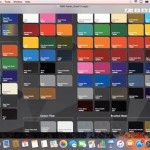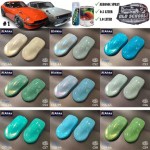Is There An App That Can Match Paint Color?
The desire to replicate a specific paint color is a common one. Whether matching an existing wall in a home, finding a complementary shade for a DIY project, or attempting to duplicate a favorite color from a photograph, accurately identifying a paint color can be a challenge. Fortunately, technological advancements have led to the development of mobile applications designed to assist in this endeavor. These apps leverage the capabilities of smartphone cameras and color sensors to analyze colors and provide matching paint options.
The core functionality of a paint color matching app revolves around colorimetry, the science of measuring and quantifying color. These apps generally work by using the smartphone's camera to capture an image of the target color. The app then processes this image, analyzing the red, green, and blue (RGB) values of the pixels within a user-defined area. This RGB data is then translated into other color spaces, such as CIELAB, which is designed to be perceptually uniform, meaning that equal numerical differences in the color space correspond to roughly equal perceived differences in color.
Once the app has a quantified representation of the target color, it compares this data against a database of paint colors from various manufacturers. The app then presents the user with a list of potential matches, often ranked by the degree of similarity to the target color. These matches may include the paint name, color code, and brand.
Accuracy and Limitations of Paint Color Matching Apps
While paint color matching apps offer a convenient solution for color identification, it’s important to understand their limitations. The accuracy of these apps can be affected by several factors.
Lighting Conditions: Ambient lighting significantly impacts the perceived color of an object. Different light sources, such as incandescent, fluorescent, or natural daylight, emit light with varying spectral compositions. This can alter the color captured by the smartphone camera, leading to inaccurate color analysis. Many apps attempt to compensate for lighting variations through calibration techniques, but these are not always perfect. It is generally recommended to take color readings in consistent and well-lit environments to improve accuracy. Furthermore, shadows and reflections can also skew the color readings.
Surface Texture and Gloss: The texture and gloss of the surface being scanned can also influence the captured color. A matte surface will scatter light differently than a glossy surface, which can affect the color readings. Additionally, the texture of the surface can create microscopic shadows that alter the perceived color. Some apps offer settings to adjust for different surface types, but users should be aware of this potential source of error.
Device Calibration and Sensor Quality: The quality of the smartphone's camera and color sensors plays a crucial role in the accuracy of the color matching. Different smartphones have varying sensor sensitivities and color processing algorithms. Some apps may require users to calibrate their device to ensure accurate color readings. It is also worth noting that even with calibration, there may be inherent limitations to the accuracy of the sensors on a mobile device compared to dedicated color measurement instruments.
Paint Formulation Variations: Even seemingly identical paint colors can vary slightly in formulation due to batch variations, changes in pigment availability, or differences in manufacturing processes. This means that even if the app provides a perfect match based on its database, the actual paint may not be an exact replica of the original color. Furthermore, the age of the paint and exposure to environmental factors can cause color fading or changes over time.
Subjective Perception: Color perception is subjective and can vary from person to person. What one person perceives as a perfect match, another may find slightly off. This is due to individual differences in color vision and interpretation. Therefore, it is always recommended to test the matched paint color in the actual environment before committing to a large-scale painting project.
Popular Paint Color Matching Apps and Their Features
Several paint color matching apps are available on both iOS and Android platforms. These include apps from major paint manufacturers as well as third-party developers. The features and functionality of these apps can vary.
Brand-Specific Apps: Many major paint manufacturers, such as Sherwin-Williams, Benjamin Moore, and Behr, offer their own paint color matching apps. These apps typically provide access to the manufacturer's complete color palette and allow users to save their favorite colors and create project palettes. They often include features such as virtual paint tools, which allow users to visualize how a paint color will look in a room before applying it. These apps tend to be best for identifying colors within the manufacturer's own offerings.
Third-Party Apps: Several third-party apps offer paint color matching capabilities that are not tied to a specific paint brand. These apps often have larger databases of paint colors from multiple manufacturers, providing users with a wider range of matching options. Some third-party apps also offer additional features, such as the ability to identify color harmonies and create color schemes based on the scanned color.
Functionality and Interface: The user interface and functionality of paint color matching apps can vary significantly. Some apps have simple and intuitive interfaces, while others offer more advanced features and settings. Some apps may require users to manually define the area of the image to be analyzed, while others automatically detect the dominant color in the image. It is important to choose an app that is easy to use and offers the features that are most important to the user.
Additional Features: Many paint color matching apps offer additional features beyond basic color matching. These may include:
- Color scheme suggestions: Based on the scanned color, the app may suggest complementary, analogous, or contrasting colors to create a harmonious color scheme.
- Virtual paint tools: These tools allow users to virtually paint a room in the app to see how the color will look in different lighting conditions and with different furnishings.
- Project management features: Some apps allow users to save their favorite colors, create project palettes, and track their paint purchases.
- Store locator: Many apps include a store locator feature to help users find the nearest retailer that carries the matched paint color.
Best Practices for Using Paint Color Matching Apps
To maximize the accuracy and effectiveness of paint color matching apps, it is important to follow certain best practices.
Proper Lighting: As mentioned earlier, lighting conditions play a crucial role in color perception. When taking a color reading, ensure that the target surface is well-lit with consistent and even lighting. Avoid taking readings in direct sunlight or under artificial lighting with strong color casts. Natural daylight is generally the best light source for color matching.
Clean Surface: Ensure that the surface being scanned is clean and free from dust, dirt, or other contaminants. These can affect the color readings and lead to inaccurate matches. Use a clean, dry cloth to wipe the surface before taking a reading.
Multiple Readings: Take multiple color readings from different areas of the target surface to account for any variations in color. Average the readings to obtain a more accurate representation of the overall color. Some apps allow users to take multiple readings and automatically calculate the average color.
Calibration: If the app offers a calibration feature, be sure to calibrate your device before taking any color readings. This will help to ensure that the app is accurately interpreting the colors captured by the camera.
Validation with Physical Samples: Always validate the matched paint color with physical paint samples before committing to a large-scale painting project. Purchase small sample cans of the matched paints and apply them to a test area in the actual environment where the paint will be used. Observe the color under different lighting conditions to ensure that it is a satisfactory match.
Consider the Sheen: Remember to consider the sheen of the paint when selecting a matching color. Different sheens, such as matte, eggshell, satin, semi-gloss, and gloss, will reflect light differently and can affect the perceived color. Choose a sheen that is appropriate for the intended application. Ensure that the sheen of the matched sample you are testing closely matches the sheen of the original paint you are trying to replicate.
By understanding the limitations of paint color matching apps and following these best practices, users can increase the likelihood of finding an accurate paint color match and achieving their desired results.
:max_bytes(150000):strip_icc()/004_best-color-matching-apps-4178379-53b94053ea94493e8eade66046201dcb.jpg?strip=all)
The 5 Best Color Matching Apps For Ios And Android

10 Paint Color App Options Every Diyer Should Know Bob Vila

Top 7 Color Match Paint Apps

Top 7 Color Match Paint Apps

Discover The Color Portfolio App Browse Match And Visualize Your Perfect Paint Benjamin Moore

Top 7 Color Match Paint Apps

Colour App Dulux

10 Paint Color App Options Every Diyer Should Know Bob Vila

Colour App Dulux

How To Use The Project Color App From Home Depot
Related Posts








